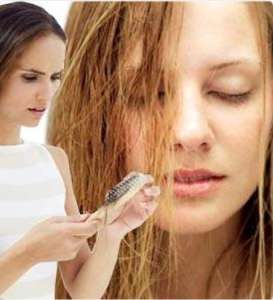 Hair fall
Hair fall
-
Also known as alopecia or baldness, is a loss of hair from the head or body. Baldness can refer to general hair loss or male pattern hair loss.
-
Hair loss from breakage of the hair shaft is different than hair loss from decreased hair growth.
-
Androgenetic hair loss (it is a male pattern hair loss in the frontal area of the scalp with or without recessions) is seen in both men and women.
-
Thyroid disease, anemia, protein deficiency, and low vitamin levels may cause hair loss.
-
Alopecia areata (localized hairless patches with normal skin) is a relatively common cause of hair loss that usually resolves on its own.
Medical health screening for hair loss may include blood tests such as complete blood count (CBC), iron level, vitamin B, Zinc, Thyroid function tests (TFT) and hormonal as DHEAS hormone.
What are causes of hair loss?
Because there are so many types of scalp hair loss, finding the cause can be challenging. Most hair loss is not associated with systemic or internal disease, nor is poor diet a frequent factor. Hair may simply thin as a result of predetermined genetic factors and the overall aging process. Many men and women may notice mild physiologic thinning of hair starting in their 30s and 40s. Life vicissitudes, including illness, emotional trauma, protein deprivation (during strict dieting), and hormonal changes like those in pregnancy, puberty, and menopause may cause a reversible hair loss. Several health conditions, including thyroid disease and iron deficiency anemia, can cause hair loss. It is important to exclude underlying causes in sudden or severe hair loss.
On the other hand, cancer chemotherapy and immunosuppressive medications commonly produce hair loss. Complete hair loss after chemotherapy regrows after six to 12 months.
Types of Hair Loss:
1-Patchy hair loss
Some conditions produce small areas of hair loss, while others affect large areas of the scalp. Common causes of patchy hair loss are
– Alopecia areata (small circular or coin size patches of scalp baldness that usually grow back within months), traction alopecia (thinning from tight braids or ponytails), trichotillomania (the habit of twisting or pulling hair out), tinea capitis (fungal infection).
2- Generalized (diffuse) hair loss
-
This is an overall hair thinning without specific bald spots or patterns. While this type of hair loss may not be noticeable to others, often the individual will feel their hair is not as thick or full as it previously was. Common conditions in this category are telogen effluvium (rapid shedding after childbirth, fever, or sudden weight loss)
-
Androgenetic or androgenic hair loss (“male-pattern baldness,” “female-pattern baldness”). This type of alopecia is often attributed to genetic predisposition and family history. Androgenic alopecia is seen in both men and women. The hair loss in men is often faster, earlier onset, and more extensive. Common baldness as “androgenetic alopecia” or “androgenic alopecia,” is due to a combination of hormones and hereditary (genetics) is needed to develop the condition. The exact cause of this pattern is unknown.
3- Can itchy scalp cause hair loss?
-
Itchy scalp may cause mild, reversible hair loss. Causes may include seborrheic dermatitis (dandruff). Treatments may include medicated shampoos, OTC dandruff shampoos, and topical steroid creams and lotions to help decrease itching.
-
Adolescent boys notice some receding near the temples as their hairlines change from the straight-across boys’ pattern to the more “M-shaped” pattern of adult men. This normal development does not mean they are losing hair.
How do people prevent hair loss?
-
Hair-loss prevention depends on the underlying cause. Good nutrition, especially adequate levels of iron and vitamin B, is helpful. Treatment of underlying medical conditions like thyroid disease, anemia, and hormonal imbalances may useful in prevention.
-
Topical applications rich in vitamins (especially Vitamin B5) in hair loss caused by stress, systemic illness etc.,
-
Minoxidil 2-5% according to the severity of androgenetic alopecia to be applied for 6-8 months then another maintenance products rich in vitamins to maintain the results and avoid recurrence
-
Mesotherapy program course using vitamins can help in mild to moferate hair loss cases
-
Platelet Rich Plasma (PRP) used with Mesogun or Dermapen helps in stopping the hair fall and increase hair growth and appearance of new baby hairs. PRP would increase vascular structure around hair follicles and hence improve the blood supply to the hair follicles thereby stimulating hair growth. It also stimulates hair shaft thickening thereby reversing hair miniaturization experienced in androgenetic alopecia
